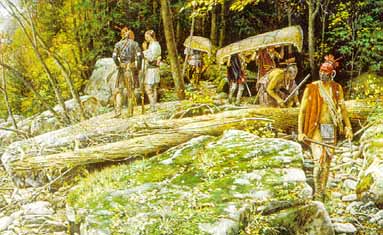

Johan Ludwig Klemmer
1718-1756
written by Charles W. Hite, Jr.
By 1750 in the British colonies of Pennsylvania, Western Maryland, and Virginia, the population has increased so much that new immigrants had to push west to get decent farmland. However, this resulted in a conflict with the Indians and their French allies who claimed all the region around the Great Lakes up to the Appalachian Mountains. The French operated out of Quebec, Canada and had a lucrative fur trading business with the Indians, who trapped the animals, ate the meat, and sold the fur to the French for guns, steel knives, and hatchets. The French shipped the fur to Europe where it was made into expensive clothing. The Indians resented the great number of British settlers who claimed Indian land, cut the trees for farms, and competed with the Indians for fish and game. The French encouraged the Indians to battle the British settlers and offered money for British scalps. The Ohio Valley Indians had always collected their enemies scalps anyway, so they thought this was an excellent idea. Unfortunately, the British participated in this atrocity also by offering 10 pounds for every French or northern Indian scalp collected. By 1754 the western frontier was a dangerous place to live. To fortify the northern borders of Virginia (including present day West Virginia), Colonial Governor Dinwiddie sent a Virginia militia unit under the command of 22 year old George Washington. Washington decided to attack the French as they constructed Fort Duquesne along the Ohio River, but in the battle he was defeated and captured. However after surrendering their weapons, and promising not to return, George Washington and his troops were allowed to return to Virginia. The next year 1755, the British General Braddock gathered a larger force that included George Washington and again attacked Fort Duquesne. This time the French and Indians were not so charitable. They killed General Braddock and dealt a crushing blow to the British column. George Washington barely escaped, but was pursued to Virginia, and was very lucky to get back alive! This disaster left the frontier settlers with no government troops to protect them.
 |
A Delaware Indian warparty prepares to cross a creek in preparation
for a surprise attack on a colonial British outpost, circa 1756. |
The next year 1756, England and France formally declared war against each other and began fighting worldwide. When the French and Indian War was over in 1763, England would own Florida and Canada. In August 1756, George Washington was once again in charge of protecting western Virginia from the French and Indians. He had mostly colonial militia with only a few trained government troops and was losing ground. About August 17, 1756, Washington wrote Lord Fairfax that the whole English settlement along the Conococheogue River had fled east in 350 wagons in only three days. Washington says "...that the Maryland settlements are all abandoned is certainly a fact, as I have had the accounts transmitted to me by several hands." On August 20, 1756, Delaware Indians attacked a "funeral train" near Hagerstown, Maryland and killed two settlers, George Hicks and Ludovich "Claymore". Although George Washington probably never met grandfather Johan Ludwig Klemmer, he was certainly aware of how and where he died. Isn't it a good thing that George Washington had better luck fighting the British than he did at fighting the Indians!
 |
On October 12, 1758, French soldiers along with their Indian allies descend
on British-held Fort Ligonier, Pennsylvania which is in the valley below. |
French and Indian War Links




